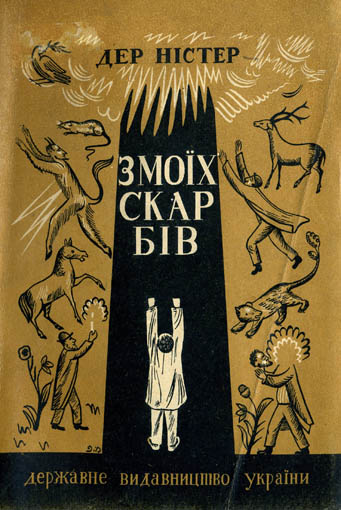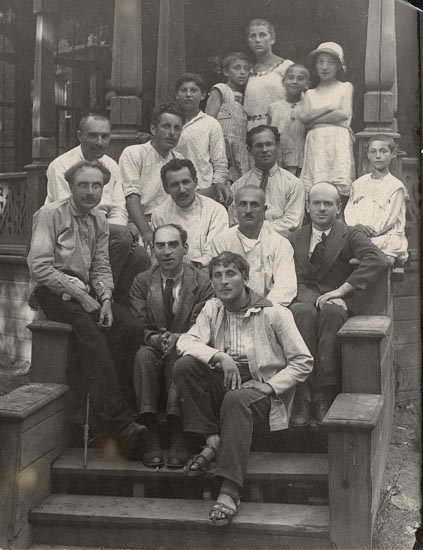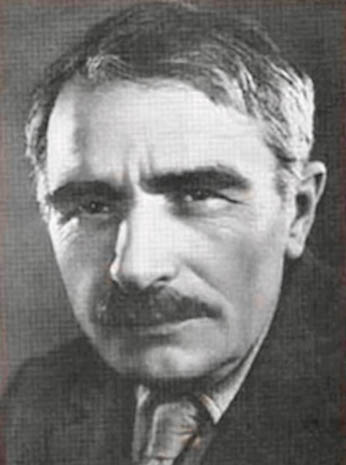Nister, Der
Nister, Der [Дер Ністер; Yiddish: ‘The Hidden One,’ a pseudonym of Pinkhus Kahanovych (Пінхус Каганович; Pinchus Kahanovich, Pinhas Kahanovitch)], b 1 November 1885 in Berdychiv, d 4 June 1950 in the Abez GULAG labor camp, Komi ASSR, RSFSR. Yiddish writer and poet. He came from the family of Orthodox Jews with ties to the Korshev (Korostyshiv) Hasidic sect. His eldest brother, Aaron, was drawn to mystical experiences at an early age and, as an adult, became a member of the sect following the teachings of Rabbi Nakhman of Bratslav. Aaron and the Bratslav stream of Hasidism exerted a profound influence on Der Nister’s future creative work. In 1904 he left Berdychiv presumably to evade service in the Russian army. The need for secrecy surrounding this evasion led him to adopt a pseudonym, and in 1907, in Vilnius, he published his first book under the pen name Der Nister: Gedanken un motiven: lider in prosa (Thoughts and Motifs: Poems in Prose). He later moved to Zhytomyr, where he worked as a Hebrew teacher. At that time he became a member of the Kyiv group of Jewish Yiddish authors. In 1910, Der Nister published Hekher fun der erd (Higher Than the Earth), a book that, like much of his writing, exhibited a mystical undercurrent of his creative thought. It reflected his profound fascination with folklore, fantasy, enigmatic language, and symbolism. His third book, Gesang un gebet (Song and Prayer) appeared in 1913.
At the outbreak of the First World War, Der Nister found employment in the timber industry in the Kyiv region. Throughout the war years he continued to write and completed his first book for children, Meyselekh in fersen (Tales in Verse, 1918). In 1918 he relocated to Kyiv, where he became part of a community that revolved around Kultur Lige. In 1920 he moved with his family to Moscow. From there he relocated via Poland to Berlin where, in 1922 and 1923, two volumes of his Gedakht (Thought) were published. In Berlin, together with David Bergelson, Der Nister edited the literary section of the magazine Milgroym. In 1926 he moved back to Ukraine and settled in Kharkiv, where in 1928 he published a collection of symbolist stories, Fun mayne gitter (From My Estates).
At the end of the 1920s, in the atmosphere of tightening Communist Party control over the arts and literature, the symbolist and mystical Der Nister came under scrutiny and harsh criticism from the Soviet authorities. For nearly a decade he lived in great poverty, supporting himself and his family by writing journalistic reports of his travels to places such as Leningrad and Moscow. These essays, when compiled into a book, were published as Hoyptshtedt (Major Cities) in 1934. In 1930 a collection of Der Nister’s works in the Ukrainian translation, entitled Z moïkh skarbiv (From My Treasures), appeared in Kharkiv under the editorship of Oleksander Finkel. In 1933 Der Nister’s translation of Ivan Kulyk’s short story from Ukrainian into Yiddish was published. The first chapter of Di mishpokhe Mashber (The Family Mashber) appeared in the journal Sovetish haymland in 1935, and in 1939 the first volume of this novel was published in a book form in Moscow. The entire novel was printed in its entirety only in the United States of America in 1948.
At the onset of the Second World War, Der Nister was evacuated to Tashkent, where he penned a series of war stories. These stories were later included in his books, including Korbones, dertseylungen (Victims, Stories) and Heshl Ansheles (Heshl, Son of Anshel). After the war, he settled in Moscow where he continued working on subsequent sections of Di mishpokhe Mashber. In 1947 he visited Birobidzhan, the Jewish autonomous region of the USSR located near the Chinese border. In February 1949, Der Nister was among the last of the Jewish writers to be arrested in connection with the so-called ‘affair of the Jewish Anti-Fascist Committee.’ Like other JAFC members, he was imprisoned, and subjected to torture. Soviet authorities officially reported his death on June 4, 1950, in an undisclosed Soviet prison hospital.
BIBLIOGRAPHY
Wolf, Leonard. ‘Introduction’ in Der Nister, The Family Mashber, trans. by Leonard Wolf (Munich 1987)
Estraikh, Gennady, Kerstin Hoge, and Mikhail Krutikov, eds. Uncovering the Hidden: The Works and Life of Der Nister (New York 2014)
Krutikov, Mikhail. Der Nister’s Soviet Years: Yiddish Writer as Witness to the People (Bloomington 2019)
Larysa Bilous
[This article was written in 2024.]



